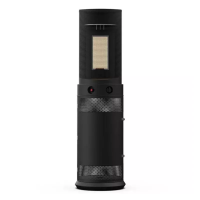Mimosa Backhaul Help Content
Mimosa Backhaul Performance
Copyright © 2014 Mimosa Page 29
TCP Performance
Mimosa Backhaul radios are designed to pass many data streams, and although a Mimosa link may have a full
gigabit of capacity, a single TCP stream will not saturate the link. However, multiple TCP streams can saturate the
link, and better represent typical backhaul applications where multiple TCP streams occur asynchronously. This can
be demonstrated by comparing single and multiple streams when testing throughput with iPerf. The reasons for this
difference are described below.
TCP Protocol Background
Transmission Control Protocol (TCP) is a connection-based protocol that requires an acknowledgement for each data
packet sent between hosts to ensure reliable communication. A sender sends a packet to a receiver, and the
receiver sends an acknowledgement back to the sender. If the sender does not receive an acknowledgement, it will
retransmit the original packet.
Each host participating in the TCP connection also has a default TCP Window Size (or TCP Receive Window) which
defines the amount of data that each host can accept without acknowledging the sender. TCP transmits data up to
the TCP Window Size and then waits for an acknowledgement, so the full capacity of the link may not be used.
Factors Affecting TCP Throughput
TCP connections, such as for file transfers and database queries, are affected by these controllable factors:
The TCP Window Size can be adjusted manually for each host that participates in the TCP connection. Most
●
operating systems adjust the TCP Window Size dynamically with maximum send and receive windows that can
be overridden, or with heuristics and scaling algorithms than can be modified or disabled. Consult your
operating system documentation for more information. Throughput test software in routers and in desktop
applications may artificially limit the TCP Window, so be sure to understand what values are applied before
drawing conclusions from the results they provide.
Internal and external network latency may also be introduced by other devices such as switches and routers
●
between each host and the Mimosa Backhaul radios. Test round trip times between devices to determine their
impact on overall latency. Link latency, or round-trip time (RTT), across the Mimosa link can be reduced in the
following ways:
Fixed TDMA: Latency can be controlled by selecting an appropriate TDMA Window setting (2/4/8 ms). The
●
round trip time (RTT) can be calculated as described within the Calculating Link Latency article, and
measured empirically with ping results.
Auto TDMA: This mode results in the lowest latency, but it is not compatible with GPS synchronized spectrum
●
sharing. The transmit window is as long as is necessary (up to 4ms) to send whatever data is available at the
time, and then control is passed back to the other side. Select "Auto" as the gender and traffic split (Wireless
> Link > TDMA Configuration) on the AP to operate in this mode.
Latency can also occur if the link is already saturated, and some TCP streams are queued while waiting for
●
access to the medium. If possible, increase channel width to add capacity, or improve SNR to enable higher
order modulation.
The Packet Error Rate (PER) can cause variations in latency because packets received with errors must be
●
resent from radio to radio at the MAC layer. This latency can cause TCP to reduce the maximum transmit
window, so care should be taken to follow the Backhaul RF Tuning Process to minimize (and stabilize) PER
before attempting throughput tests.

